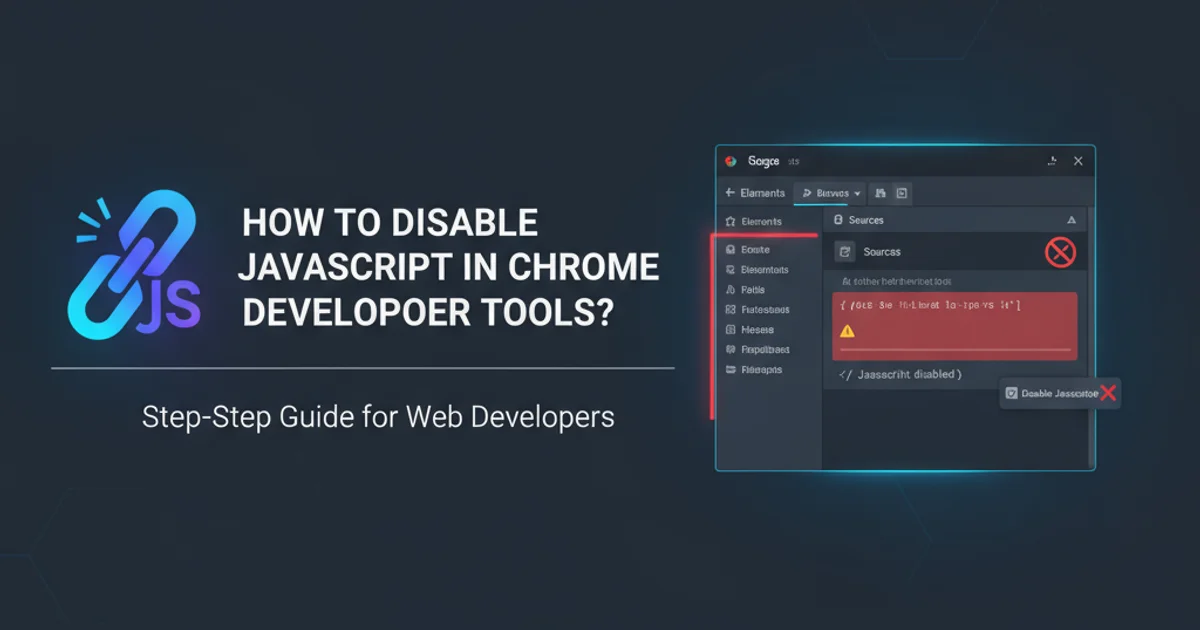How to disable JavaScript in Chrome Developer Tools?
Categories:
How to Disable JavaScript in Chrome Developer Tools

Learn how to quickly disable JavaScript in Google Chrome's Developer Tools for debugging, testing, and security analysis of web pages.
Disabling JavaScript is a crucial step for web developers, QA testers, and security researchers. It allows you to observe how a website behaves without its dynamic scripting, helping to identify issues, test fallback content, or analyze potential vulnerabilities. Google Chrome's Developer Tools provide a straightforward way to toggle JavaScript on and off without needing to change browser settings globally.
Why Disable JavaScript?
Understanding the reasons behind disabling JavaScript can help you leverage this feature effectively:
- Debugging and Testing: Identify if a bug or unexpected behavior is caused by JavaScript or by the underlying HTML/CSS structure. Test how your website functions for users with JavaScript disabled, which is important for accessibility and progressive enhancement.
- Performance Analysis: Observe page load times and rendering without JavaScript execution to pinpoint performance bottlenecks.
- Security Audits: Analyze how a site behaves when scripts are not running, which can reveal server-side vulnerabilities or reliance on client-side validation.
- Content Accessibility: Ensure that critical content remains accessible even when JavaScript fails or is intentionally blocked by the user.
flowchart TD
A[Start Debugging Session] --> B{Need to Isolate JS Issues?}
B -- Yes --> C[Open Chrome DevTools]
C --> D[Navigate to 'Settings']
D --> E[Find 'Debugger' Section]
E --> F[Check 'Disable JavaScript']
F --> G[Reload Page]
G --> H[Observe Behavior Without JS]
H -- Done Testing --> I[Uncheck 'Disable JavaScript']
I --> J[Reload Page]
J --> K[End Debugging Session]
B -- No --> KWorkflow for Disabling JavaScript in Chrome DevTools
Method 1: Using DevTools Settings
This is the most common and recommended method for temporarily disabling JavaScript for the current tab. It's quick, easy to toggle, and doesn't affect other tabs or browser windows.
1. Open Chrome Developer Tools
Right-click anywhere on the web page and select 'Inspect' from the context menu, or use the keyboard shortcut: Ctrl+Shift+I (Windows/Linux) or Cmd+Option+I (macOS).
2. Access DevTools Settings
In the Developer Tools panel, click the vertical ellipsis (three dots) icon ... in the top-right corner. From the dropdown menu, select 'Settings' (or press F1).
3. Navigate to the Debugger Section
In the Settings panel, go to the 'Preferences' tab (which is usually the default). Scroll down until you find the 'Debugger' section.
4. Disable JavaScript
Check the checkbox labeled 'Disable JavaScript'. Once checked, JavaScript will be disabled for the currently active tab.
5. Reload the Page
To see the effect, you must reload the web page. You can do this by pressing F5 or clicking the reload button in the browser. The page will now render without executing any JavaScript.
6. Re-enable JavaScript
To re-enable JavaScript, simply uncheck the 'Disable JavaScript' checkbox in DevTools settings and reload the page again.
Method 2: Using the Command Menu (Faster Toggle)
For those who prefer keyboard shortcuts and a faster workflow, the Command Menu offers a very efficient way to toggle JavaScript.
1. Open Chrome Developer Tools
Use Ctrl+Shift+I (Windows/Linux) or Cmd+Option+I (macOS).
2. Open the Command Menu
While DevTools is open, press Ctrl+Shift+P (Windows/Linux) or Cmd+Shift+P (macOS). This will open the Command Menu.
3. Type and Select 'Disable JavaScript'
Start typing disable javascript into the Command Menu search bar. You will see an option like 'Disable JavaScript'. Select it and press Enter.
4. Reload the Page
Reload the page (F5) to observe the changes. The Command Menu will confirm that JavaScript is disabled.
5. Re-enable JavaScript
To re-enable, open the Command Menu again (Ctrl+Shift+P or Cmd+Shift+P), type enable javascript, select 'Enable JavaScript', and press Enter. Remember to reload the page.